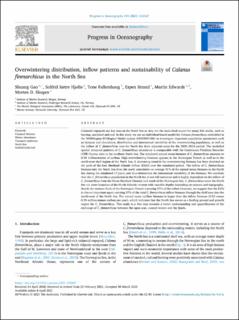| dc.contributor.author | Gao, Shuang | |
| dc.contributor.author | Hjøllo, Solfrid Sætre | |
| dc.contributor.author | Falkenhaug, Tone | |
| dc.contributor.author | Strand, Espen | |
| dc.contributor.author | Edwards, Martin | |
| dc.contributor.author | Skogen, Morten D. | |
| dc.date.accessioned | 2021-10-04T09:00:29Z | |
| dc.date.available | 2021-10-04T09:00:29Z | |
| dc.date.created | 2021-08-31T15:37:16Z | |
| dc.date.issued | 2021 | |
| dc.identifier.citation | Progress in Oceanography. 2021, 194 1-11. | en_US |
| dc.identifier.issn | 0079-6611 | |
| dc.identifier.uri | https://hdl.handle.net/11250/2787392 | |
| dc.description.abstract | Calanoid copepods are key taxa in the North Sea as they are the main food source for many fish stocks, such as herring, mackerel and cod. In this study we use an individual-based model for Calanus finmarchicus embedded in the NORWegian ECOlogical Model system (NORWECOM) to investigate important population parameters such as biomass and abundance, distribution and interannual variability of the overwintering population, as well as the inflow of C. finmarchicus into the North Sea from adjacent areas for the 2000–2016 period. The modelled spatial–temporal patterns of C. finmarchicus abundance is comparable with the Continuous Plankton Recorder (CPR) Survey data in the northern North Sea. The simulated annual mean biomass of C. finmarchicus amounts to 0.94 million-tonnes of carbon. High overwintering biomass appears in the Norwegian Trench as well as in the north-west shelf region of the North Sea. A decreasing trend in the overwintering biomass has been detected on the path of the East Shetland Atlantic Inflow (ESAI) over the simulated period. The inflow of C. finmarchicus biomass into the North Sea from the north constitutes on average 41% of the annual mean biomass in the North Sea during the simulated 17 years, and thus determines the interannual variability of the biomass. We conclude that the C. finmarchicus population in the North Sea is not self-sustained and is highly dependent on the inflow of C. finmarchicus from the Faroe-Shetland Channel and south of the Norwegian Sea. C. finmarchicus enter the North Sea via three branches of the North Atlantic current with variable depths depending on seasons and topography. Beside the western flank of the Norwegian Trench (carrying 57% of the inflow biomass), we suggest that the ESAI is also an important agent carrying 37% of the total C. finmarchicus inflow biomass through the shelf area into the north-west of the North Sea. The annual mean outflow biomass is larger than the inflow biomass (0.52 versus 0.39 million-tonnes carbon per year), which indicates that the North Sea serves as a feeding ground and growth region for C. finmarchicus. This study is a first step towards a better understanding and quantification of the exchange of C. finmarchicus between the open seas, coastal waters and the fjords. | en_US |
| dc.language.iso | eng | en_US |
| dc.title | Overwintering distribution, inflow patterns and sustainability of Calanus finmarchicus in the North Sea | en_US |
| dc.type | Peer reviewed | en_US |
| dc.type | Journal article | en_US |
| dc.description.version | publishedVersion | en_US |
| dc.source.pagenumber | 1-11 | en_US |
| dc.source.volume | 194 | en_US |
| dc.source.journal | Progress in Oceanography | en_US |
| dc.identifier.doi | 10.1016/j.pocean.2021.102567 | |
| dc.identifier.cristin | 1930183 | |
| dc.relation.project | Havforskningsinstituttet: 15197 | en_US |
| cristin.ispublished | true | |
| cristin.fulltext | original | |
| cristin.qualitycode | 1 | |
